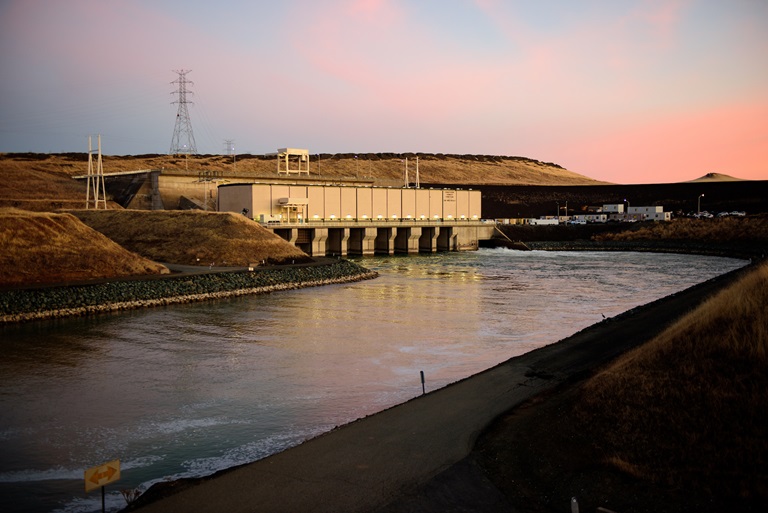Lake Oroville Community Update - October 30, 2020
A morning sunrise over the Ronald B. Robie Thermalito Pumping-Generating Plant, located at the Thermalito Afterbay. DWR/2017.
Fire Impacts to Lake Oroville
The Department of Water Resources (DWR) is a member of the “Watershed Working Group” led by the California Office of Emergency Services (Cal-OES). The working group is a multi-agency team evaluating and identifying areas of concern in the Feather River watershed affected by recent wildfires. Field teams are taking action to address erosion, debris runoff, and water quality impacts. DWR’s Division of Flood Management is currently assisting California Conservation Corps members to install erosion control measures in areas of concern.
DWR water quality experts have expanded water sampling activities at Lake Oroville and continue to monitor for algal blooms and other environmental concerns. After the 2018 Camp Fire, data collected by DWR environmental scientists showed no long-term impacts to water quality in Lake Oroville.
The clearing of debris entering Lake Oroville is part of ongoing DWR maintenance of Lake Oroville. Additional work is planned to protect boaters and ensure safe operation of dam facilities. Several ancillary DWR facilities around Lake Oroville experienced fire damage. DWR staff are making repairs to the impacted facilities.
Oroville Recreation
The Lime Saddle and Oroville Dam Spillway boat ramps remain open. The Bidwell Canyon boat launch will be closed Oct. 31 to Nov. 6 for construction work to build boat ramp lanes to 700 feet, providing additional boat access when lake levels are low. Weekend access from 5 a.m. Saturday to midnight Sunday is expected to resume Nov. 6. The project is expected to be completed mid-November.
The Potter’s Ravine and North Fork trails near the Spillway boat launch area and trails in the Loafer Creek Recreation Area are closed to repair fire damage. Enterprise, Stringtown, and Foreman Creek boat ramp areas, the Loafer Creek Recreation Area, and Lake Oroville Visitor Center also remain closed.
Visit the California Parks Lake Oroville State Recreation Area (LOSRA) webpage for current information on facility status as well as current requirements to protect public health during the COVID-19 pandemic. Information is also available on DWR’s Lake Oroville Recreation webpage. For information about the Oroville Wildlife Area, including the Thermalito Afterbay, visit the California Department of Fish and Wildlife webpage.
Plumas National Forest
While many areas of Plumas National Forest near Oroville and the upper watersheds of the Feather River remain closed due to the North Complex, Walker, and Sheep fires, nearly two-thirds of the Forest is open for recreation, including DWR’s Lake Davis and Frenchman Lake. Campgrounds have closed but trails, boating, and other recreation is allowed. Visitors are advised to be alert for firefighting equipment and personnel. Visit the Plumas National Forest webpage for fire restrictions, alerts, notices, and maps.
Oroville Recreation Advisory Committee to Meet
The Oroville Recreation Advisory Committee (ORAC) will meet Nov. 6. Due to the COVID-19 pandemic, the meeting will not be open to the public to protect public health. ORAC was established by the Federal Energy Regulatory Commission (FERC) to review and provide recommendations regarding the DWR Recreation Plan for the Lake Oroville State Recreation Area. To obtain a summary of the meeting, send a request to oroville@water.ca.gov.
Bryozoans Return to Lake Oroville
Have you seen these ‘creatures’ in Lake Oroville? Bryozoans are aquatic invertebrates. But instead of being a single organism like jellyfish, bryozoans are made up of thousands of individual microscopic animals called zooids, living in a colony. A single colony can grow to be 12-20 inches in diameter and many can grow close together, creating a large mass. More commonly found in lakes in the eastern United States, they have migrated via birds, winds, and other means to western lakes. They appear regularly in Lake Oroville during the late summer or early fall and can be found free-floating in the water or attached to submerged branches, ropes, or even houseboat pontoons.
DWR’s Water Wednesdays Are Taking A Winter Break
DWR initiated an online educational program “Water Wednesdays” to share information about a wide range of topics related to California’s water resources. Targeted to kids 10 to 14, but appropriate for anyone, each half-hour episode on Zoom was live, allowing participants who signed up to ask real time questions of the speaker.
Since its start in May of 2020, this family-friendly program has covered topics ranging from fish and birds living in the Delta, climate change, the importance of groundwater, and following salmon on their journey to the Pacific and back to their home rivers. Previous episodes of Water Wednesdays are available on DWR’s YouTube channel – enter Water Wednesdays in the search bar. Look for Water Wednesday episodes to return in January 2021.
Current Lake Operations
The elevation of Oroville’s reservoir is about 731 feet and storage is about 1.50 million acre-feet. Beginning this weekend and into next week, dry conditions and temperatures ranging in the low 80s are expected.
The total releases to Feather River continue at 2,450 cfs to meet downstream Bay-Delta water quality and flow standards. The Feather River flows consist of 800 cfs through the Low Flow Channel adjacent to the City of Oroville, and 1,650 cfs from the Thermalito Afterbay Outlet (Outlet) for a total of 2,450 cfs for the Feather River’s high flow channel downstream of the Outlet.
All data as of midnight 10/29/2020
